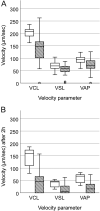The impact of percutaneous epididymal sperm aspiration on sperm quality in mice
- PMID: 37227214
- PMCID: PMC10305637
- DOI: 10.1530/RAF-23-0017
The impact of percutaneous epididymal sperm aspiration on sperm quality in mice
Abstract
Abstract: In laboratory mice, sperm quality is usually assessed in spermatozoa collected from the cauda epididymidis of freshly sacrificed males. Percutaneous epididymal sperm aspiration (PESA) is a non-terminal alternative that would allow repeated sperm collection for sperm quality assessment in living males. To test whether PESA is a suitable method to assess sperm quality, we compared sperm traits between samples collected by PESA vs the commonly applied terminal cauda epididymidis dissection. The collected sperm samples were analyzed using computer-assisted sperm analysis and various parameters, including sperm motility, swimming velocity and morphology, were determined. We were able to retrieve motile sperm from all mice using PESA and the terminal cauda epididymidis dissection. Based on computer-assisted sperm analysis, however, sperm motility and swimming velocity were significantly lower after PESA compared to samples obtained by cauda epididymidis dissection. In addition, we found significantly more morphological abnormalities in PESA samples, probably induced as a side effect of the sampling technique. Although sperm samples collected by PESA are successfully used for in vitro fertilization, we cannot recommend PESA as a suitable method to assess sperm quality in mice, since the procedure seems to impair various sperm traits.
Lay summary: In mice, sperm quality is usually assessed in sperm collected from the epididymis (organ where ripe sperm is stored) of euthanized males. However, there is one non-terminal and minimal invasive alternative to collect sperm, called percutaneous epididymal sperm aspiration (PESA), which allows repeated sample collections from the same individual. Given that individual sperm quality is variable and can change according to various factors, PESA could allow to track sperm quality over time and would be highly appreciated in different research fields. Here, we tested the suitability of PESA to determine sperm quality by comparing sperm samples collected by PESA vs the commonly applied terminal epididymis dissection. We used computer-assisted sperm analysis to determine various sperm quality traits. Surprisingly, we found that sperm collected by PESA showed significantly reduced motility, swimming velocity and more morphological abnormalities compared to sperm samples collected by epididymis dissection. Thus, we cannot recommend PESA as a suitable method to determine sperm quality traits as the procedure itself seems to affect collected sperm cells.
Keywords: CASA; epididymal sperm; mouse; non-terminal; sperm collection; sperm quality assessment; sperm traits.
Conflict of interest statement
All authors declare that there is no conflict of interest that could be perceived as prejudicing the impartiality of the research reported.
Figures






Similar articles
-
Studies of percutaneous epididymal sperm aspiration (PESA) and intracytoplasmic sperm injection.Hum Reprod Update. 1998 Jan-Feb;4(1):57-71. doi: 10.1093/humupd/4.1.57. Hum Reprod Update. 1998. PMID: 9622413
-
Fertilizing capacity of rat spermatozoa is correlated with decline in straight-line velocity measured by continuous computer-aided sperm analysis: epididymal rat spermatozoa from the proximal cauda have a greater fertilizing capacity in vitro than those from the distal cauda or vas deferens.J Androl. 1996 Jan-Feb;17(1):50-60. J Androl. 1996. PMID: 8833741
-
Microsurgical and Percutaneous Epididymal Sperm Aspiration for Sperm Collection from Live Mice.J Am Assoc Lab Anim Sci. 2015 Sep;54(5):471-7. J Am Assoc Lab Anim Sci. 2015. PMID: 26424244 Free PMC article.
-
Quality of canine spermatozoa retrieved by percutaneous epididymal sperm aspiration.J Small Anim Pract. 2013 Feb;54(2):87-91. doi: 10.1111/jsap.12020. J Small Anim Pract. 2013. PMID: 23373835
-
Sperm retrieval and fertilization in repeated percutaneous epididymal sperm aspiration.Hum Reprod. 1998 Oct;13(1O):2805-7. doi: 10.1093/humrep/13.10.2805. Hum Reprod. 1998. PMID: 9804234
Cited by
-
A simple method for repeated in vivo sperm collection from laboratory mice.J Assist Reprod Genet. 2024 Sep;41(9):2537-2546. doi: 10.1007/s10815-024-03201-x. Epub 2024 Jul 17. J Assist Reprod Genet. 2024. PMID: 39017771 Free PMC article.
-
Bridging the Gap: Animal Models in Next-Generation Reproductive Technologies for Male Fertility Preservation.Life (Basel). 2023 Dec 21;14(1):17. doi: 10.3390/life14010017. Life (Basel). 2023. PMID: 38276265 Free PMC article. Review.
References
-
- Behringer R Gertsenstein M Nagy KV & Nagy A. 2014Manipulating the Mouse Embryo: a Laboratory Manual. Cold Spring Harbor Laboratory Press.
MeSH terms
LinkOut - more resources
Full Text Sources

